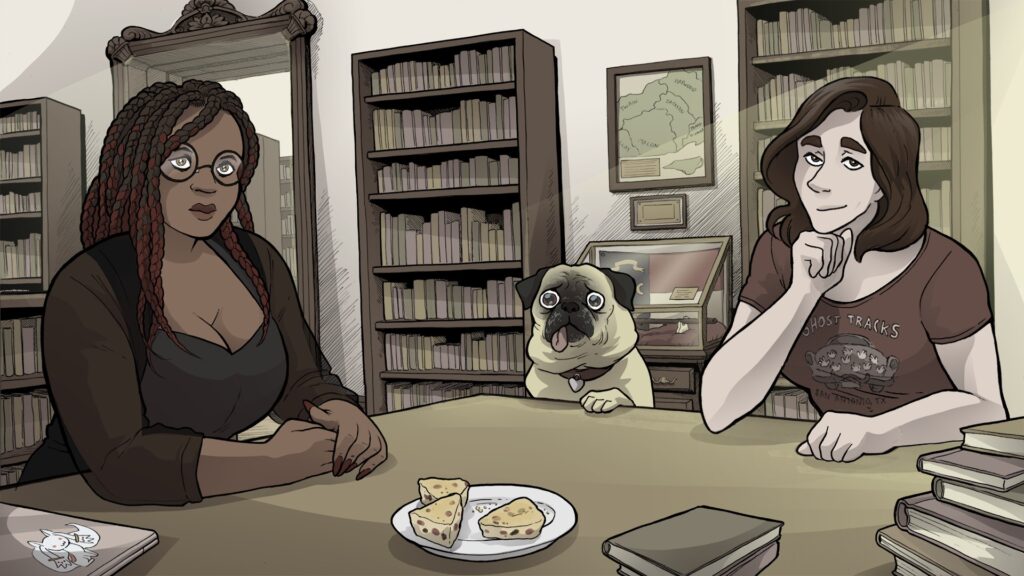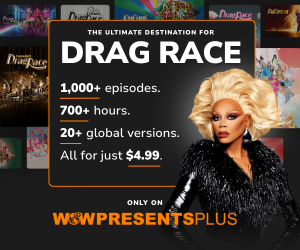Tradition is the real queer horror in Scarlet Hollow
Scarlet Hollow, a visual novel horror game, came at the right time for Abby Howard, and Tony Howard-Arias.
“I was working on a graphic novel pitch that wasn’t quite coming together, and Tony’s startup was winding down.” Howard tells us. “They were helping me out at New York City Comic-con and we got to talking with a friend of ours about horror dating simulators, and that night, we both got a lot more serious about it and wound up brainstorming.”
That brainstorming led to Scarlet Hollow, and with the concept of the horror-mystery game coming to life shortly before the COVID-19 pandemic spread across the world, it left both the wife and husband team with plenty of time to sit down and create.
Fast forward to now, and Scarlet Hollow is two chapters in out of seven and is highly regarded by Kotaku’s John Walker as having one of the best narratives he’s ever played. That’s high praise by itself, but considering this is Black Tabby Games, the studio founded by both Howard and Howard-Arias, first ever game too… You couldn’t ask for a more positive reception.
Considering Howard’s roots as a webcomic artist and cartoonist behind works like The Last Halloween, The Crossroads at Midnight, and The Earth Before Us, some might be curious on why they didn’t stick to their strengths and develop another comic. For Howard-Arias the answer was simple: the story just wouldn’t work without the player character being stuck right in the mud alongside the rest of the town’s inhabitants.
“At [Scarlet Hollow’s] core, it’s about dealing with the damage of what people you’ve never met before have left behind. That narrative becomes so much more effective if you, the player, have to directly deal with it, rather than looking in on the story as an observer.” Howard-Arias explains. “Also making a video game seemed fun, and we were both into the idea of making something that didn’t require manufacturing and shipping physical goods.”

For Howard it went even further than that; Scarlet Hollow’s branching narrative offered an intriguing challenge that they couldn’t find anywhere else but in a visual novel horror game. Sure there were more than a few different options to consider — the player character has six different traits they can pick after all, and each trait gives you opportunities that lead you to down different routes — but that also gave Howard more freedom with the game’s narrative and choices.
Instead of having to decide one ending to wrap up the mysteries that plague the Appalachian mining town that’s Scarlet Hollow’s setting, the format of a choice-based game gave Howard the option to write all her ideas without having to cut away anything. “I don’t have to choose [the ending] for Scarlet Hollow! The pressure is off, the player has to make that decision for me.” Howard says. “And if someone doesn’t like the ending they get, they can always make different choices and wind up with an ending that better suits their tastes!”
One thing that isn’t a choice is how abundantly queer Scarlet Hollow is, and we’re not just saying that because there are LGBTQ+ romance options and characters within this small mining town.
When we first looked at the game for our Gayme of the Week series of reviews, we described Scarlet Hollow as something that knows it’s uncomfortable and odd and out of place — a feeling that we know all too well while living in a cis and heteronormative society, and a feeling that breathes anxious life into the best that horror has to offer. It’s no surprise then that the LGBTQ+ community flocks to this feeling like moths to a flame.
On one hand, Howard acknowledges that there can be something euphoric in consuming content that makes you face the horror you’ve experienced. “It’s a way to think about what threatens you or makes you uncomfortable in an abstract and often less upsetting way,” she says. There’s no threat of physical harm for one, with four walls surrounding you and the safety of your friends and family so very close.
But also, there’s something perfectly fine with consuming the horror and the violence of otherness in Scarlet Hollow — and any other medium — because you like that stuff. As Howard says, “it doesn’t have to be therapeutic, sometimes you’re just a weirdo who likes that bad feeling.”

A particularly horrific feeling that’s been at the forefront of Scarlet Hollow since the very first episode is the role of tradition, and how tradition can ultimately lead to the loss of self – the thing that makes you, well, you. And for your character, the child of an outcast mother who left her family behind to get away from the turmoil of both her relatives and the mines they own, eyes are on you the moment you enter town.
What’s worse, the player character doesn’t know just how wrapped up they are in the town’s traditions and expectations. Howard explains that they can’t get into too much how queerness interacts with the major plot points of Scarlet Hollow, but tells us that “the main thrust of the game is that the main character finds themselves wrapped up in traditions and expectations they never realized they inherited.” And of course while the powers maintaining those roles are complex and not necessarily evil, Howard concedes that there is horror at being forced into a traditional role they’ve never wanted to be in.
The strength of those roles are reflected not just in the player character and the world, but in the characters you meet as well. You’ve got a handful of romance options, each are outsiders in the town and like you, their roles have led them to face opposition, subtle or otherwise. It’s what makes them stand out, and draw themselves to you.
Scarlet Hollow is on its second chapter, and with five more chapters to go it’s unknown how many more twists and turns Abby Howard and Tony Howard-Arias have in store for fans. But what we do know is this: it’s going to be the spookiest, engaging queer journey… one that you don’t want to miss out on.
Scarlet Hollow (Chapter 1+2) is available to play over on Steam.







